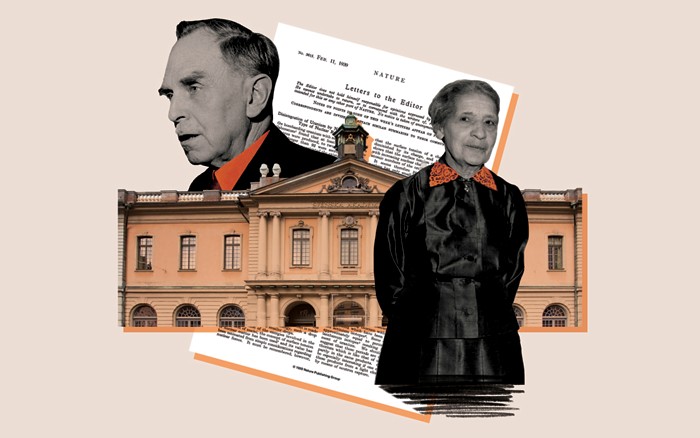Advertisement
Grab your lab coat. Let's get started
Welcome!
Welcome!
Create an account below to get 6 C&EN articles per month, receive newsletters and more - all free.
It seems this is your first time logging in online. Please enter the following information to continue.
As an ACS member you automatically get access to this site. All we need is few more details to create your reading experience.
Not you? Sign in with a different account.
Not you? Sign in with a different account.
ERROR 1
ERROR 1
ERROR 2
ERROR 2
ERROR 2
ERROR 2
ERROR 2
Password and Confirm password must match.
If you have an ACS member number, please enter it here so we can link this account to your membership. (optional)
ERROR 2
ACS values your privacy. By submitting your information, you are gaining access to C&EN and subscribing to our weekly newsletter. We use the information you provide to make your reading experience better, and we will never sell your data to third party members.
ACS News
Fred Hawthorne, inorganic chemist nicknamed Mr. Boron, dies
The Priestley medalist helped put boron chemistry on the map
by Alla Katsnelson, special to C&EN
July 12, 2021

Colleagues sometimes called M. Frederick Hawthorne “Mr. Boron,” and it was a nickname he embraced. He often said that boron was his element, but then he’d quickly clarify that it wasn’t that he owned boron—but rather, that boron owned him.
Hawthorne, who established the field of boron chemistry almost single-handedly and won countless awards for his research, including the Priestley Medal in 2009 and the National Medal of Science in 2011, died on July 8. He was 92.
“We went from boron chemistry in its infancy in the 1950s to the field today—largely because of the efforts and progress that Fred Hawthorne pushed forward,” says Mark W. Lee, who was a PhD student in Hawthorne’s lab in UCLA from 1999 to 2005 and remained a long-time friend and colleague.
“He became the master of boron hydride chemistry—that will forever be linked with the name of Hawthorne,” says J. Fraser Stoddart, a chemist at Northwestern University and corecipient of the 2016 Nobel Prize in Chemistry.
Hawthorne was born in Fort Scott, Kansas, in 1928 and got his bachelor’s degree in chemistry at Pomona College in 1949. He went on to earn his PhD in 1953 at the University of California, Los Angeles, under Donald J. Cram, corecipient of the 1987 Nobel Prize in Chemistry.
Hawthorne began investigating boron chemistry shortly after finishing his doctorate, as a researcher at the Redstone Arsenal research division of the Rohm and Haas Company in Huntsville, Alabama. The lab was primarily working on propellants and other chemicals relating to rockets. Chemists had recently synthesized a new class of propellant, decaborane (B10H14), but it needed modification to be widely taken up as rocket fuel. A new manager—Warren Niederhauser, who later became president of ACS—wanted to push the lab’s research into more ambitious territory, and he asked Hawthorne to launch a research group to conduct basic research on boron chemistry. “I thought it was bad stuff, but I said, yes, I would be happy to do it,” Hawthorne reminisced in a 2013 interview published in Future Medicinal Chemistry (DOI: 10.4155/fmc.13.49). “I ran to the library and looked up boron chemistry in an old textbook. I figured this was a real opportunity as new one knew much about it.”
In 1969, after a few academic hops, Hawthorne returned to his alma mater, the University of California, Los Angeles, as a full professor and remained there for almost 40 years. By then, he’d fallen deeply in love with boron chemistry, and during his years at UCLA he made a wide range of contributions to the field. “Fred really did a phenomenal job at putting boron chemistry on the map,” says Omar K. Farha, who did his PhD under Hawthorne at UCLA in 2002–2006. “When he started, there were few boron-based molecules out there, but he really helped draw the blueprint for that field.”
Students saw Hawthorne as a tremendous mentor. “He always pushed me to think deeply about my science and my projects, and I believe I am the scientist that I am right now because of that.” says Farha.
The fuel for Hawthorne’s drive was unbridled excitement about science. “When it came to scientific ideas, he was like a child opening presents on Christmas morning,” says Lee, now the president of Twelfth Vertex, a company that commercializes aspects of boron chemistry.
Students and faculty members alike also appreciated his warmth and collegiality. “He was a really good departmental citizen,” says inorganic chemist Jeffrey I. Zink, who came to UCLA in 1970, a year after Hawthorne. “I considered him a good role model who was really very good at taking care of his students and postdocs.”
Stoddart recalled moving to UCLA from the UK in 1997 and getting a call from Hawthorne on his second or third day, inviting him to lunch at the faculty club. “When we sat down at a small table and looked at each other, Fred said to me, ‘What can I do to help you?’” Stoddart says. “It was such a warm and embracing kind of greeting, and it was always in that vein that I saw him.”
Hawthorne also contributed to the wider chemistry community by being the longest-serving editor in chief of Inorganic Chemistry, which he grew from a small and relatively insignificant journal to one to the biggest and most prominent ACS publications between 1969 and 2001. “He was editor in chief for 32 years, and I can tell you he personally read every single paper that was ever submitted during that period,” says Lee.
Over the course of his career, Hawthorne became increasingly interested in boron neutron capture therapy (BNCT), a radiotherapy in which boron is administered to tumors and then irradiated with a neutron beam to selectively kill cancer cells. In 2006, he retired from UCLA and moved to the University of Missouri. The institution offered Hawthorne a dedicated thermal neutron beam line specifically for BNCT research, and he launched the Institute of Nano and Molecular Medicine.
“Early in his career, at Rohm and Haas, he worked on molecules as rocket fuels, but later on in his life, he used similar molecules for neutron-based radiation and nanomachines,” says Farha. “It takes a brilliant mind to be able to span that range of chemistries.”





Join the conversation
Contact the reporter
Submit a Letter to the Editor for publication
Engage with us on Twitter